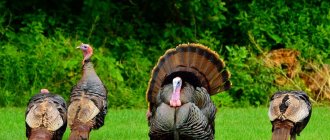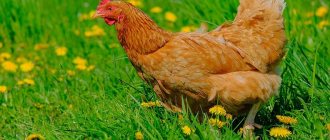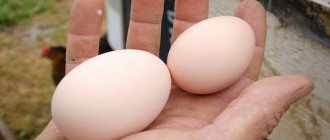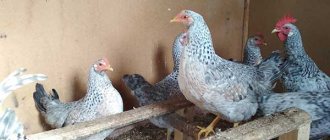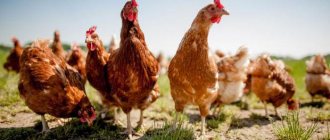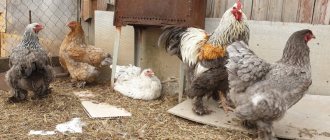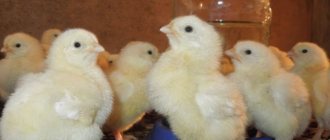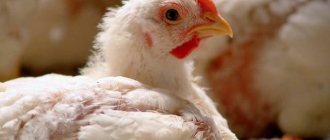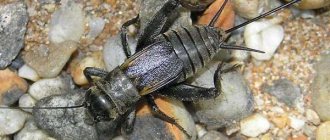Chickens can be meat, egg, decorative and mixed (universal) varieties. When growing at a poultry farm, producers focus on only one indicator: a large carcass, high quality meat or a large number of eggs.
Meat-and-egg chickens can provide the poultry farmer with carcasses and the optimal number of eggs.
For home breeding, meat and egg breeds of chickens that are distinguished by their unpretentiousness, good growth rate and abundant laying are more suitable.
Breed characteristics of meat and egg chickens
Universal breeds are the result of long-term crossing of meat and egg chickens. In most cases, their mixed productivity is not a natural feature, but the result of the work of breeders.
By what characteristics are they distinguished?
Despite their different origins, meat and egg breeds of chickens have a number of common characteristics:
- the body is dense, the plumage is thick and loose;
- wings are poorly developed;
- the character is peaceful and calm, although males can get into fights;
- due to long-term selection, many breeds are resistant to infectious diseases;
- hatchability and survival rates of young animals reach 98%;
- maternal instinct depends on the genetic line, but most breeds tend to be brooding.
Meat-and-egg chickens have a dense build.
The characteristics of each type of meat and egg chicken can be found in the description of the breeds.
Productivity table
Productivity of universal chickens:
| Meat (poultry weight) | Egg | ||||
| Chicken | Rooster | Average slaughter time | Masonry, pcs. in year | Average egg weight | Period of decline in egg production |
| 2.0-3.5 kg | 2.7-4.0 kg | 8-9 months | 180-220 | 55-65 g | 1.5-3 years |
The productivity of chickens also depends on the consumer qualities of the meat. Generalist carcasses have a good fillet yield and medium fat content. Rooster meat may have small layers of fat that make it more tender and juicy.
Mixed bird broths and stews are tender and flavorful.
Andalusian chicken
Chickens with an unusual color find themselves only on private farmsteads, since the breed is not used on an industrial scale due to its low (industrialists’ opinion) egg production.
The young begin to lay eggs at six months of age, with eggs weighing 55-62 grams. Egg productivity is 185 eggs per year. Andalusian chickens can also be used for meat; the weight of chickens reaches an average of 2.7 kg. The instinct for incubation is underdeveloped, but it is possible to obtain a brood with high survival rate. However, to get numerous offspring, it is better to use an incubator.
Advantages and disadvantages of station wagons
The main advantage of all-purpose chickens is the ability to simultaneously obtain a large amount of meat and eggs for nutrition and breeding.
In addition, mixed breeds have the following advantages:
- increased resistance to cold and disease;
- rapid adaptation to new conditions when changing food, transportation, quarantine, etc.;
- high hatchability of chickens and flock survival;
- calm disposition, absence of noise, friendliness towards the owner, animals and birds;
- high consumer qualities of meat and eggs;
- preserved maternal instinct (in some breeds).
Generalist chickens quickly adapt to new conditions.
All-purpose chickens are good foragers, so in spring and summer the cost of feed and mash decreases. Since the wings of most meat and egg breeds are not developed, it is enough to fence the yard with a mesh fence up to 1.5 m high.
The disadvantages include the following aspects:
- the growth rate is significantly lower than that of broiler hybrids and meat crosses;
- the period of puberty is quite long, and the average annual clutch is small;
- Many breeds (for example, Amroks, Orpingtons, etc.) hatch more males than females, which does not correspond well to the main principle of breeding.
General characteristics
If you look closely at the name of the group, you can safely conclude that from the universal bird you can get not only a large number of eggs, but also sufficient meat. Each breed has individual external characteristics, the same applies to productive qualities, but there are a number of common features characteristic of all birds:
- strong physique;
- rapid ripening;
- most chickens show good egg production in winter;
- presence of maternal instinct.
As for the maintenance of meat-egg representatives, most breeds will not require the creation of any special conditions. Birds have a calm character; a closed chicken coop is suitable for them to live in. The presence of a walking aviary will be an undoubted advantage for creating a comfortable life for chickens, but universal birds can do just fine without such excess.
Chick selection
It is recommended to buy chickens for replacement of livestock at large poultry farms or from trusted large breeders. Inexperienced owners often make mistakes in breeding and crossing chickens.
When choosing chickens, you need to pay attention to the following signs:
- Behavior is active. The chicks do not sit still, squeak softly, do not huddle in a corner or huddle together.
- The abdomen is not distended, elastic to the touch. There are no traces of feces, pus or blood near the cloaca.
- The eyes are alive and clear. There are no stuck areas around.
Chicks must have an active behavior.
To check the chicken's health, you can close it in a small cardboard box and lightly tap the lid. A healthy chick will quickly approach the source of the sound.
Before purchasing, it is recommended to find out the average price of chickens. A discount of more than 10% may indicate culling or other deficiencies in the brood. The future owner should evaluate not only the appearance and condition of the chicks, but also the exterior of the parent individuals.
If you have a warm, equipped chicken coop and experience in rearing, you should choose day-old or week-old chickens. You need to buy them in April in order to get a sufficiently mature herd in October-November.
If there is no insulated room, you can purchase 30-day-old chicks. Before purchasing, you need to find out whether the chickens are vaccinated and with what vaccines.
Russian white
The Russian White breed of egg hens was bred by selective selection and crossing Leghorn chickens. In fact, in each country the breed is represented by several intra-breed types, ..., with local rural breeds, so birds of this breed have inherited the best qualities from Leghorns.
The Russian white hen gives average eggs up to 60 grams; during the year such a bird lays about 200 eggs. The main characteristics of the Russian White chicken are a slightly hanging comb and a white color. From the Leghorns the breed inherited a weak instinct for incubating eggs.
With age, the egg production of the Russian breed decreases from 244 eggs per year to 210. Therefore, long-term maintenance is considered inappropriate. The advantages of “Russian” birds include good immunity, resistance to frost, they are unpretentious and hardy, even unheated premises on private farmsteads are suitable for keeping them.
The best varieties of meat and egg chickens with descriptions
When choosing chickens, you need to evaluate not only their productivity, but also the complexity of keeping them. The farmer’s income will depend on the ratio of primary investments (in lighting, heating the poultry house, arrangement of the yard), current expenses (for food, treatment), quantity and quality of the product received.
Some poultry keepers prefer chickens with good decorative qualities to decorate their yard. To evaluate the exterior, photographs of classic representatives of the breeds are suitable.
Farm breed Australorp
The breed was developed in Australia at the end of the 19th century. To ensure high productivity, breeders crossed the classic representatives of the egg, meat and meat-egg varieties: Leghorns, Langshans and Orpingtons.
The Australorp is a breed of chicken native to Australia.
The most popular color of Australorps is black. There are also blue, white, wheaten, gold, red, silver and marbled (black and white) chickens. The weight of an adult laying hen reaches 3.5 kg, and that of a male – 4.5 kg. Over the course of a year, a chicken produces 200-240 eggs weighing about 60 g. Laying begins at 4 months, and a decline in productivity occurs only at 2 years.
Australorps are flexible, phlegmatic and peaceful. They rarely vocalize, get along well with other birds and quickly adapt to the yard.
The website has a detailed article on how to breed Australorps.
Marana chickens
Maranas were bred in France in 1895. Due to their powerful body, resistance to adverse conditions and high quality eggs, they quickly became popular throughout the world.
The weight of a chicken reaches 3.3 kg, and that of a rooster – 4 kg. The carcasses have an attractive appearance due to their light skin, and the meat has good taste.
Marana chickens are distinguished by their large egg size.
Egg production in laying hens is average: only 130-160 eggs. in year. Sexual maturity of chickens occurs at 5.5-6 months. The intensity of the masonry depends on the air temperature and the length of daylight hours. The eggshell is dark and thick. This barrier protects the protein from infection from the surface.
Marana chickens have a developed maternal instinct.
The breed has a large number of acceptable colors.
The plumage of chickens and roosters can be golden, lavender, black, speckled (cuckoo), copper-black, white, Colombian, etc.
Poltava clayey
Poltava clay chickens were bred in Ukraine in the mid-20th century. The basis was taken from local breeds, as well as the most common and productive foreign ones - Orpingtons, New Hampshires, etc.
The Poltava clay breed of chickens was bred in Ukraine.
Poltava birds are resistant to cold, unpretentious and calm. They have dense plumage, most often brown, but there are black and speckled varieties. Sexual maturity occurs at 5 months, simultaneously with the start of laying. The weight of an egg is 55-60 g; a laying hen produces an average of 190 eggs per year. Laying hens have a well-developed brooding instinct.
The weight of the carcass is small - only 2.0-3.5 kg, but the meat is juicy and tender.
Leningrad chintz, beloved by gourmets
The Leningrad calico breed was obtained in several stages. The selection included Leghorn, Australorp, New Hampshire, Leningrad White and Poltava Clay chickens. From the photo you can appreciate the variegated decorative colors of calico birds.
The Leningrad calico breed of chickens belongs to the meat and egg breed.
The weight of a laying hen is up to 2.2 kg, and that of a rooster is up to 2.7 kg. Despite their light weight, calico chickens are valued for their productivity, since the meat is white, juicy and nutritious. Females gain weight faster than males.
The average annual clutch of laying hens is 160-180 eggs, the weight of which is 58-60 g.
Representatives of this breed are quite friendly and peaceful, but are distinguished by their curiosity, activity and love of walks.
Compact mini
Breeding miniature chickens is widespread mainly in Europe. Dwarf birds have beautiful reddish or white plumage, making them a great addition to the yard. Despite the presence of fluff, they are sensitive to cold and require keeping in an insulated chicken coop.
Compact mini chickens were bred as a result of selective breeding.
The weight of an adult laying hen does not exceed 1.8-2.0 kg, and that of a rooster – 2.3-2.5 kg. In appearance, dwarf chickens are similar to Rhode Island chickens. The egg productivity of compact individuals is 180-190 eggs. in year. The average egg weight is 55 g.
The advantages of mini breeds are the possibility of dense planting in the poultry house, strong immunity and lower feed costs.
Dwarf chickens consume 30-35% less food than standard-sized chickens.
Rhode Island breed
This breed was named after the state of the same name, which is still one of the leaders in American poultry farming.
Rhode Islanders are growing fast. Females gain up to 2.9 kg, and males gain up to 3.9 kg. Chickens mature at 7 months. The hen brings up to 170 large eggs per year.
Rhode Island is a meat and egg breed of chicken.
Both chickens and roosters have a calm character, but need walking. A large yard with plenty of greenery significantly reduces feed costs.
They are undemanding when it comes to diet and tolerate food changes well. When breeding, you need to carefully monitor the temperature in the house. Extreme conditions sharply reduce the survival rate of young and adult livestock.
Large Liven Calico chickens
Liven calico chickens are similar to Leningrad chickens in color, but, unlike them, they are the result of folk selection. Due to long-term natural crossing, the breed is distinguished by a variety of colors.
Liven calico chickens are similar to Leningrad chickens in color.
Liven chickens have a dense body weighing up to 3.4 kg in females and up to 4.4 kg in males. The meat of these birds is tender and lean. Chickens begin to lay eggs late, at 8 months, but remain productive up to 4.5-5 years. The average annual clutch is 210-220 eggs, their average weight is 60 g.
Naked breed of birds
Bare-necked chickens have characteristic external features and high endurance. The breed is widespread in the CIS countries and Europe.
The weight of chickens reaches 2.5 kg, roosters - 3.5 kg. Naked neck carcasses are easy to pluck, and the meat tastes similar to turkey.
The naked-necked bird is an easy breed to care for.
Laying hens begin laying eggs at 6 months. The average annual productivity is 170-180 pcs. Chicks are practically devoid of the brooding instinct, but hatching chicks have good survival rates.
Farmer's Ukrainian earflaps
This breed is widespread in Russia and Ukraine. Despite their small size and average egg production (160-190 eggs per year), these chickens are highly valued by farmers for their good survival rate, unpretentiousness and developed maternal instinct.
Ukrainian earflaps have become widespread in Russia.
Ushankas adapt well to any conditions, are insensitive to cold and resistant to viral diseases. The weight of an adult chicken is 1.8-2.3 kg, a rooster - 2.3-2.8 kg. The maximum egg productivity of laying hens is observed only in the first year, and then decreases. They lay their first clutch at 6-7 months.
The oldest European breed is the Welsumer.
Welsumers were bred at the beginning of the 20th century. in the Netherlands. As they spread in Europe, they were crossed with local meat and egg breeds, obtaining an increasingly more productive cross.
Welsumers have a dense build, a rounded silhouette and motley plumage. Classic breed colors are red-partridge, silver and golden.
Welsumer is a meat and egg breed of chicken.
The weight of an adult rooster reaches 3.5 kg, a chicken – 2.5 kg. Laying hens become productive from 5.5 months, producing up to 160 eggs per year. From one and a half years, the masonry decreases by 15-20%.
Chickens have no brooding instinct. Welsumers are friendly towards humans, but roosters can be aggressive towards other inhabitants of the poultry house.
Yerevan chickens
The Yerevan breed was obtained by crossing local Caucasian chickens with New Hampshire and Rhode Island chickens. The official standard was only approved in 1974.
These chickens have a powerful body with a wide chest and dense plumage of a red-brown color. The weight of the rooster reaches 3.5-4.5 kg. Laying hens are significantly smaller and grow to only 2-3 kg.
Yerevan chickens - the works of Armenian breeders.
The first clutch occurs at 6-7 months. Over the course of a year, chickens produce up to 200 eggs weighing about 60 g. Productivity is maintained for 2-3 years.
Yerevan birds are calm, not prone to fights, and adapt well to new environments. Laying hens are able to hatch their offspring independently.
California chickens
Thanks to the mixture of Leghorn and Plymouth Rock genes, the California Gray breed is one of the leaders in egg production. The average annual laying volume of laying hens is 220-240 pieces. Egg production lasts for 2-3 years.
California chickens are medium-sized birds.
They have a beautiful striped color, so some farmers breed them as ornamental eggs.
The weight of a chicken is 2.3-2.5 kg, and that of a rooster is up to 3 kg. Maturation occurs at 5.5-6 months. Only 30-40% of laying hens are prone to incubation.
Plymouthrocks
The Plymouthrock breed was bred by American breeders in the second half of the 19th century. The ancestors of meat-and-egg chickens were Spanish black roosters, Langshans, Brahmas, Coninhins and Dominican chickens.
Plymouthrocks are a breed of chickens producing meat and eggs.
The advantages of the breed are its beautiful color, friendly disposition and undemanding conditions.
The average weight of a chicken is 3 kg, a rooster is 4 kg. Birds gain maximum weight by six months. Females begin to lay eggs at 6 months. You can get up to 200 eggs per year.
Sussex breed
Sussex is one of the oldest meat and egg breeds. Its first representatives were bred in the Roman Empire, but it was finally formed in the English county of the same name. To increase productivity, Sussexes were crossed with Brahms, Dorkings and Coninchins.
The Sussex breed is popular among Russian breeders.
The most common is the Colombian color of birds, which is why they are also considered decorative. By nature, Sussexes are calm and affectionate.
Adult males weigh up to 4 kg, and females weigh up to 3 kg. Sussex meat is tender, lean, and high in protein. Laying hens mature in 5.5-7 months and produce up to 190 eggs per year. They have a well-developed brooding instinct.
Faverolles
Faverolles is a French breed that was developed by crossing Coninchins, Dorkings, Brahms and Houdans. They are distinguished by a calm character, good immunity and beautiful plumage with thick down. Classic colors are salmon (Lachshuner), blue and silver (California).
Faverol is a godsend for Russian poultry farmers.
Due to the fact that meat and broth breeds were used in the selection, fireballs have quite a lot of weight. The weight of a chicken is 3-3.5 kg, and that of a rooster is 4-4.5 kg. Carcasses are easily plucked and retain their presentation for a long time after slaughter.
In the first year after maturation, hens lay up to 180 eggs per year, in subsequent years - no more than 130. The incubation instinct is poorly developed. The hatchability of fireballs in the incubator is about 75%.
To prevent injury and illness, you need to properly set up and clean your chicken coop regularly. Perches for firewood should be low.
Amrox chickens
Amroks are highly productive birds that are characterized by good survival and rapid growth. To breed the breed, breeders used Coninhin, black Javanese and Dominican chickens. The color of Amroks is cuckoo, with contrasting thin stripes.
Amroks are an American breed of chickens.
The weight of an adult female is up to 3 kg, the male – up to 4 kg. The first clutch can be obtained no earlier than 6 months. In the first year of activity, chickens lay up to 220 eggs, after which productivity decreases by 10-15%.
English Orpington
Orpington is one of the heaviest representatives of the meat and egg trend. Representatives of the breed have a powerful, square body with a massive shoulder girdle and a large chest.
The weight of chickens reaches 4 kg, and roosters - 5 kg. Puberty occurs at 7 months. In the first year of laying, hens produce 140-170 eggs per year, and after that the productivity decreases. Because of this, it is recommended to update the livestock once every 2 years.
Orpington is a breed of chicken of English origin.
The main disadvantage of the breed is the tendency to obesity, which negatively affects the laying and quality of meat.
Handsome Lakenfelders
The first mention of Lakenfelder chickens is found in sources of the first half of the 18th century. This breed was raised in the Netherlands, Belgium and Germany. Over time, it was replaced by more productive species, so in the middle of the 20th century. Lakenfelders were endangered.
Lakenfelders have thick and dense plumage.
The productivity of these chickens is low. Adult females weigh no more than 1.8 kg, and males - 2.5 kg. They gain maximum weight by 9 months. Chickens mature at 6-7 months, and in the first year of laying they produce up to 190 medium-sized eggs.
The advantages of the breed are beautiful plumage, strong maternal instinct, resistance to cold and good survival of offspring. The disadvantages of Lakenfelders are noise, the ability to fly high, and a high percentage of rejection due to their exterior.
Moscow chickens
This breed was bred in Russia in the second half of the 20th century. Nowadays there is only 1 subspecies of the breed - Moscow Black. The white variety is preserved only in separate collections and genetic reserves.
Moscow hens are a group of chickens producing eggs and meat.
The weight of a chicken is up to 2.5 kg, and that of a rooster is 3.5 kg. Due to the developed muscles, carcasses have a large percentage of meat. Moscow laying hens mature in 5-7 months. The average annual laying of such a chicken is 200-230 eggs.
Birds of the Moscow breed are distinguished by their docile nature, friendliness and low activity during walks. Laying hens have a well-expressed brooding instinct. They have only 2 significant drawbacks - a tendency to obesity and average immunity.
Strong breed Foxy Chick
Hungary is considered the birthplace of Foxy Chick chickens. The name of the breed is due to its bright red color. Due to their characteristic colors and large size, these birds are called red broilers or Hungarian giants.
The robust Foxy Chick breed is a popular bird that is bred by many breeders.
The weight of a foxy chick rooster reaches 5.5-6 kg, and a chicken – 4 kg. This breed is distinguished by record egg productivity: in the first year of laying, laying hens produce up to 300 eggs. In subsequent years, this figure drops sharply, so the herd needs to be renewed regularly. Chickens reach maturity early - at 4-5 months. Red hens are good hens.
Along with its high productivity, the breed has many disadvantages. Foxy Chick chickens are noisy, uncooperative and quite aggressive.
Zagorsk salmon
The Zagorsk salmon breed was obtained from New Hampshire, Rhode Island, Russian White and Yurlovsky vocal chickens. The name is due to the soft red hue of the bird's body and wings. Closer to the tail the color turns into dark brown or black, and on the belly it turns into light brown. Zagorsk roosters have a darker and more contrasting color.
Salmon Zagorsk chickens are the pride of Russian breeders.
The weight of an adult laying hen is up to 2.7 kg, and that of a male is up to 3.6 kg. Zagorsk chickens grow quickly: by 4-5 months you can get a carcass of 1.5 kg. In addition, the breed is characterized by high egg production (up to 260 eggs per year, egg weight - 60-85 g). When crossed with other chickens (Cornish, Cuchinese, Plymouth Rocks and Adlers), productive mixes with high survival rates are obtained.
The disadvantages of the breed are the ability to fly and the habit of damaging garden plantings. To avoid loss of crops and livestock, the owner will have to build a closed enclosure or a 2-2.5 m high fence around the exercise yard.
Hercules birds
Hercules is a Ukrainian breed that was bred in 2000. It received its name due to its strong build and large mass. The productivity of chickens correlates with color. Golden and speckled are the best layers, and white representatives of the breed have the heaviest weight.
Chickens gain up to 3.5 kg, and roosters gain up to 4.5 kg. Puberty occurs at 4.5-6 months. From this point on, chickens begin to produce an average of 200 eggs per year. Up to 40% of their mass is the yolk.
Hercules chickens are considered one of the best all-purpose poultry.
By nature, Hercules are quite active, lively, but at the same time peaceful. The incubation instinct in laying hens is little expressed.
Other versatile breeds
Mixed breeds also include:
- Wyandotte;
- Kuchinsky Jubilee;
- Tsarskoselskaya;
- Bresse-Gallic;
- New Hampshire;
- Bielefelder;
- Master Gray;
- Lakedanzi;
- Adlerskaya.
The Wyandotte breed is known for its versatility.
Let's sum it up
If you decide to have meat and egg birds, you can choose a breed based on your personal preferences and habitat.
If there is a farm or fair near you that sells a certain breed of chicken, choose another to get rid of the competition.
Building a chicken coop requires not only money and time, but also sufficient space in the yard. Please note that a large number of chickens need personal space, and cramped conditions will negatively affect their immunity and productivity.
The most unpretentious breeds to keep are the Barnevelder, Kotlyarevskaya, Poltava and Moscow white breeds. Therefore, if you do not have enough time, choose just such a poultry.
Now you know which breed is best to buy for home breeding for eggs and meat.
Share information with your friends. Please rate it if the article was useful to you. Comments are open for communication.
Source
Breeding Features
When breeding meat and egg chickens, you need to provide them with a balanced diet. It should include not only grain crops, which accelerate weight gain, but also protein products, animal feed, mineral and vitamin supplements.
Generalists can be kept on the floor or in cages. The first option is more complex because it requires the construction of a spacious chicken coop, but provides higher quality meat. The second method is only suitable for birds that are not prone to obesity.
Most chicks are hatched in incubators. After birth, chicks are kept in a warm brooder until they grow warm fluff.
Depending on which breed is taken for breeding, the proportions of males and females should be from 1:6 to 1:12. To avoid loss of the flock of breeding roosters, it is recommended to duplicate.
Broiler specifics
Many novice poultry farmers plan to breed broilers at home. The main thing is to provide the young animals with nutritious food. At the very beginning of breeding, chickens should be given starter feed, to which it is useful to add a finely chopped chicken egg. Water should be poured into special drinking bowls to prevent the chickens from accidentally getting wet. Young animals should always have food in their feeders, but it should be changed regularly to avoid souring.
Broyels do not provoke fights, and despite their large size and considerable strength, they often suffer from attacks from their smaller breeds, which are more aggressive.
Gradually, bone meal, chalk or crushed eggshells can be introduced into the diet. Be sure to add fresh spring greens. At the beginning of cultivation, the temperature should be at least + 350C, which is gradually lowered by about 2 degrees per day.
Comparison of breed productivity
Comparison of productivity of the best meat and egg breeds:
| Breed | Chicken weight, kg | Rooster weight, kg | Masonry, pcs. in year | Egg weight, g |
| Australorp | 3,0-3,5 | 4,0-4,5 | 200-240 (in some cases – up to 300) | 55-60 |
| Maran | 2,5-3,3 | 3,5-4,0 | 130-150 (can reach 250) | 60-85 |
| Poltava clayey | 2,0-2,5 | 3,0-3,5 | 160-220 | 55-60 |
| Leningradskaya calico | 2,0-2,2 | 2,4-2,7 | 160-180 | 58-60 |
| Mini | Up to 2 | Up to 2.5 | 180-190 | 55 |
| Rhode Island | 2,5-2,9 | 3,1-3,9 | 160-170 | 58-63 |
| Livenskaya calico | 3,0-3,4 | 4,0-4,4 | 210-220 | 55-60 |
| Goloshennaya | 2,0-2,5 | 3,0-3,5 | 170-180 (in some cases – 150-160) | 55-60 |
| Ukrainian earflaps | 1,8-2,3 | 2,3-2,8 | 160-190 | 50-55 |
| Welsumer | 2,2-2,5 | 3,2-3,5 | 150-160 | 60-65 |
| Yerevan | 2,3-2,5 | 3.3-3.5 (individuals - up to 4.5 kg) | 170-175 (in some groups – 180-230) | 55-60 |
| Californian | 2,3-2,5 | 2,7-3 | 220-240 | 55-60 |
| Plymouth Rock | 2,7-3,4 | 3,6-4,3 | 180-200 | 56-60 |
| Sussex | 2,7-3,2 | 3,5-4,2 | 160-190 (in the first year of laying - up to 250-260) | 50-60 |
| Faverolles | 3,0-3,5 | 4,0-4,5 | 160-180 | 60 |
| Amrox | 2,5-3,5 | 3,5-4,5 | 180-220 | 55-60 (they become smaller when laid early) |
| Orpington | 3,5-4 | 4,5-5 | 160 | 50-60 |
| Lakenfelder | 1,5-1,8 | 2,3-2,5 | 160-190 | 50-60 |
| Moscow | 2,0-2,5 | 3,0-3,5 | 200-230 (under optimal conditions – up to 260-280) | 55-60 |
| Foxy Chick | 3,5-4 | 5-6 | 260-300 | 60-70 |
| Salmon Zagorskaya | 2,5-2,7 | 3,0-3,6 | 250-260 | 60-89 |
| Hercules | 3,2-3,5 | 4,2-4,5 | 190-220 | 64-70 |
Ushanka, “universal” chicken
A representative of the egg breed of chickens, which can also be included in the meat and egg group. Representatives of this breed can hardly be called large; the average weight of a bird is 2.5 kg. Egg production is average 185 eggs of medium and small size per year. The weight of one egg does not exceed 55 grams. The Ushanka breed begins to lay eggs late and only produces its first eggs at the age of six months.
Ushanka is called so because of its kind of “sideburns” over the lobes and a tufted beard. The color of the chickens is brown and mottled black. The breed tolerates bad weather and frost very well, as it was bred in harsh, not laboratory, conditions.
Breeders did not scrutinize the poultry and indiscriminate crossing with chickens of other breeds did not lead to an increase in productivity, but on the contrary began to transfer the breed from an egg orientation to a meat one. If we compare the care of earflaps and egg crosses, Crosses are a hybrid of two or more breeds or populations (lines) of high... chickens, then crosses are a hybrid of two or more breeds or populations (lines) of high... chickens, having found themselves in conditions where earflaps show average egg production, they will not lay eggs at all, so the bird is perfect for beginning farmers who are not ready to devote “24 hours a day” to the bird.
The bird of this breed is unpretentious, winters well in unheated rooms, and does not require high-quality feed. In rural farmsteads it is often found as the dominant species, along with Leghorns and Russian Whites.
Bare-necked chickens
The ancient breed, originally from Romania, was originally called the Transylvanian Hollowneck. But after the improvement of the infusion of new blood, the indication of origin disappeared, and bare-necked chickens spread throughout the world.
The bird got its name due to the complete absence of any traces of plumage on its neck. On the rest of the body, the feather also grows unevenly, and some parts of the body are bare, like the neck of birds. With such an original appearance, naked chickens are a meat-egging variety that regularly produces up to 150–180 eggs annually and grows up to 3.5 kg in weight.
Pushkin chickens
Black-and-white Pushkin chickens received breed status not so long ago, but have already won sincere respect from poultry farmers. Some even call this variety of meat-egging birds the best for personal backyards. And there is every reason for such an opinion. First of all, chickens of this meat-egg breed are distinguished by their endurance and rapid acclimatization to any, even the most severe, conditions.
They are unpretentious, are excellent at finding food on their own when walking, are early maturing, and stand out from their relatives by their high egg productivity.
Roosters weigh up to 3 kg, chickens are a kilogram lighter. In a year, a laying hen can produce about 220 eggs with light cream or white shells. Chickens of this breed are distinguished by the fact that, with a relatively modest weight, they produce a well-fed, attractive carcass.
Broiler chickens
The well-known broiler chickens are not a meat breed, as many novice poultry farmers think. These are crosses - offspring from interbreed pairs of birds of the Plymouth Rock and Cornish breeds. Sometimes other meat breeds are also introduced into the broiler chicken production program, for example, Jubilee Kuchinsky, Brama or Cochin. Such chickens exhibit record meat productivity, but do not pass on their qualities to their offspring, so they are kept only until they reach marketable weight and are sent for slaughter.
Why is this type better than others?
It is accepted as a basis that such a breed has a lighter and more proportional bone structure, unlike those raised for meat, but is slightly larger than those chickens that only lay eggs.
Their plumage is quite thick and uniformly dense. This allows the bird to adapt well to sub-zero temperatures. Without additional lighting, egg production may decrease in winter, however, this phenomenon is typical for almost all birds. A mandatory requirement for keeping such chickens is a clean and dry poultry house or cage, without the slightest suspicion of drafts. This type of bird is considered more active and inquisitive, and more prone to “communicate” with people.
Chickens Amrox
The ancient American breed of Amrox chickens has a characteristic “cuckoo” coloration, and according to the standard, each feather must end with a dark stripe. Due to the wider black markings on their plumage, females appear darker than males.
Having appeared in Europe, meat-egg chickens have established themselves as excellent laying hens, producing up to 220 eggs annually, as well as good meat birds. An adult rooster grows up to 4.5 kg, a chicken is one kilogram lighter. Amrox chickens have a calm disposition, quickly get used to new living conditions and grow well.
Chickens Kuchinsky Jubilee
To develop the domestic breed of chickens, the Kuchinsky Jubilee breeders used representatives of the best varieties of egg and meat-egg varieties. The result was a bird with decent egg production and good meat productivity. Truly versatile chickens have become a godsend for owners of small private farms and farmsteads who raise poultry for personal needs. Over the course of a year, Kuchin laying hens produce up to 240 eggs, and the adult population grows to 3–4 kg of live weight.
At the same time, the quality of meat of the Kuchinskaya Yubileiny breed is better than that of industrially bred broiler chickens. The bird is not capricious, easily tolerates both heat and winter cold, is not picky when choosing a diet and is precocious.
A characteristic feature of this breed of chickens is the difference in coloring of males and females, so you can easily separate a flock even at one day of age.
Cochin chickens
The Chinese breed of chickens in Russia began to gain popularity quite recently, but in the middle of the century before last it managed to serve peace between Great Britain and the Middle Kingdom. Thanks to their lush plumage and extremely large size, the birds were a success not only among peasants and cooks, but also among owners of country estates, where Cochin chickens were raised as ornamental ones.
Representatives of this meat breed quickly and very actively gain weight. Roosters grow up to 6 kg, chickens are a couple of kilograms lighter. At the same time, the bird lays eggs well, producing 120 eggs per year with a brownish shell and a bright yolk.
If at first Cochin chickens were predominantly black or blue, today farms breed white and beautiful fawn birds. Chickens of the meat or egg-meat breed are not picky, calm, and get along with other birds. However, poultry farmers need to ensure that their pets do not overeat, otherwise they risk obesity.
Red white-tailed mini chickens
Among the breeds of meat and egg-meat chickens there are both giants and dwarfs. Breeders who obtained red white-tailed chickens in the UK used a natural mutation, which manifested itself in the fact that the birds’ legs were significantly shorter than those of their ancestors. Meat-egg chickens weigh no more than 1.7 kg and produce 150 brown eggs annually.
Mini meat chickens are very popular in European countries. They consume less feed, which has a positive effect on the cost of both meat and egg products, and are also unpretentious and easy to maintain. Today, in addition to the traditional red and white color, you can see birds dressed in white, black-red, gray-black feathers, with calico and smoky colors.
Mini meat chickens are not bred within the breed, but are used to produce fast-growing crosses that retain their parental habits. They eat little and are actively gaining weight.
